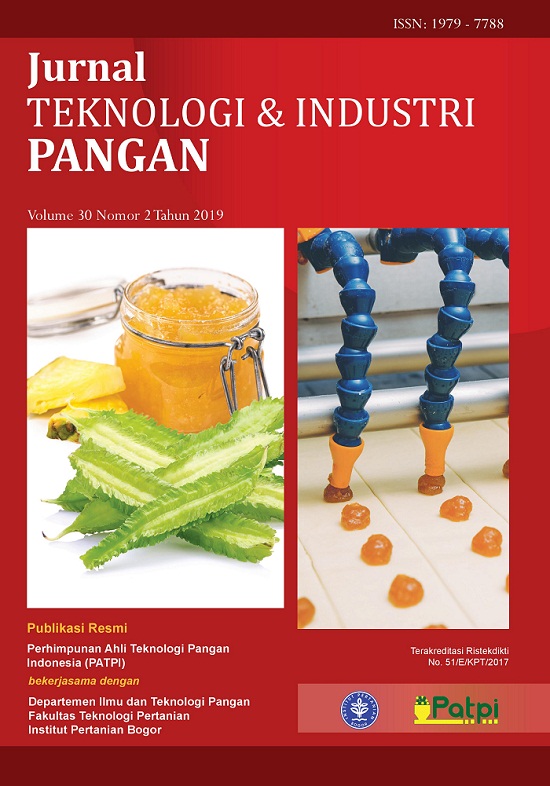STABILITAS MIKROKAPSUL Lactobacillus acidophilus ATCC 314 TERHADAP PEMANASAN DAN PENYIMPANAN DALAM SELAI BUAH NANAS RENDAH GULA
Abstract
References
Burgain J, Gaiani C, Linder M, Scher J. 2011. En-capsulation of probiotic living cells: From labo-ratory scale to industrial applications. J Food Eng 104: 467-483. DOI: 10.1016/j.jfoodeng.20 10.12.031.
Coorey R, Tjoe A, Jayasena V. 2014. Gelling pro-perties of chia seed and flour. J Food Sci 79: 859-866. DOI: 10.1111/1750-3841.12444.
Fleet GH. 2010. Yeast Spoilage of Foods and Beverages. Di dalam: Kurtzman CP, Fell JW, Boekhout T. The Yeasts (Fifth Edition). 53-63. Elsevier B.V. DOI: 10.1016/B978-0-444-52149-1.00005-7.
Grosso CRF, Fávaro-Trindade CS. 2004. Stability of free and immobilized Lactobacillus acidophilus and Bifidobacterium lactis in acidified milk and of immobilized B. lactis in yoghurt. Braz J Microbiol 35: 151-156. DOI: 10.1590/S1517-83 822004000100025.
Harmayani E, Ngatirah, Rahayu ES, Utami T. 2001. Ketahanan dan viabilitas probiotik bakteri asam laktat selama proses pembuatan kultur kering dengan metode freeze dan spray drying. J Teknol Industri Pangan 12: 126-132.
Hossain MF, Akhtar S, Anwar M. 2015. Nutrional va-lue and medicinal benefits of pineapple. Int J Nutr Food Sci 4: 84-88. DOI: 10.11648/j.ijnfs.20 150401.22.
Jafarei P, Ebrahimi MT. 2011. Lactobacillus acido-phillus cell structure and application. Afr J Microbiol Res 5: 4033-4042. DOI: 10.5897/AJM R11.630.
Jati AUP, Jenie BSL, Suliantari. 2015. Mikroenkap-sulasi Lactobacillus sp. dengan teknik emulsi dan aplikasinya pada dodol sirsak. J Teknol Industri Pangan 26: 135-143. DOI: 10.6066/jtip. 2015.26.2.135.
Kailasapathy K. 2002. Microencapsulation of probio-tic bacteria: Technology and potential applica-tions. Curr Issues Intest Microbiol 3: 39-48.
Kechagia M, Basoulis D, Konstantopoulou S, Dimi-triadi D, Gyftopoulou K, Skarmoutsou N, Fakiri EM. 2013. Health Benefits of Probiotics: A Re-view. ISRN Nutr 2013: 1-7. DOI: 10.5402/2013/ 481651.
Lye HS, Rusul G, Liong MT. 2010. Removal of cho-lesterol by lactobacilli via incorporation and con-version to coprostanol. J Dairy Sci 93: 1383-1392. DOI: 10.3168/jds.2009-2574.
Mandal S, Hati S. 2017. Microencapsulation of Bacterial Cells by Emulsion Technique For Pro-biotic Application. Didalam Emmanuel C, Opa-ra, (Ed). Cell Microencapsulation: Methods and Protocols, Methods in Molecular Biology. 273-279. Springer Science Business Media, New York. DOI: 10.1007/978-1-4939-6364-5_22.
Mansouripour S, Esfandiari Z, Nateghi L. 2013. The effect of heat process on the survival and in-creased viability of probiotic by microencapsula-tion - a review. Ann Biol Res 4: 83-87.
Mutia AK, Yunus R. 2016. Pengaruh penambahan sukrosa pada pembuatan selai langsat. Jtech 4: 80-84.
Pandey KR, Naik SR, Vakil BV. 2015. Probiotics, prebiotics, and synbiotics - a review. J Food Sci Technol 52: 7577-7587. DOI: 10.1007/s13197-015-1921-1.
Purnasari N, Jenie BSL, Nuraida L. 2015. Karak-teristik mikrokapsul Lactobacillus plantarum dan stabilitasnya dalam produk selai salak. J Teknol Industri Pangan 26: 90-99. DOI: 10.6066/jtip. 2015.26.1.90.
Rawat S. 2015. Food Spoilage: Microorganisms and their prevention. Asian J Plant Sci Res 5: 47-56.
Saputro TA, Permana IDGM, Yusasrini NLA. 2018. Pengaruh perbandingan nanas (Ananas como-sus L. Merr.) dan sawi hijau (Brassica juncea L.) terhadap karakteristik selai. J Ilmu Teknol Pangan (ITEPA) 7: 52-60.
Silva PT, Fries LLM, Menezes CR, Holkem AT, Schwan CL, Wigmann EF, Bastos JO, Silva CB. 2014. Microencapsulation: concepts, me-chanisms, methods and some applications in food technology. Cienc Rural 44: 1304-1311. DOI: 10.1590/0103-8478cr20130971.

